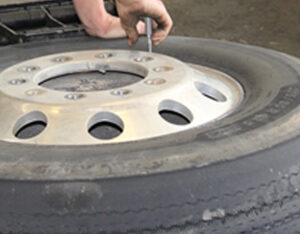Understand Tread Wear Patterns for Better Performance
Proper tires in good condition are essential for safe driving, transferring the engine’s torque and the driver’s control to the road surface to provide traction and directional control. But what’s going on when you see unusual tread wear? There are several “usual suspects” that affect a tire’s performance and safety.
Irregular Drive Tire Wear Patterns
- Multiple Cuts/Chunking: Numerous small cuts to the tread surface with portions of tread removed, giving a rough appearance
- Vehicle/Spin Damage: Cuts or lines 360˚ around the tire
- Brake Skid Damage: Localized spot of excessive wear across tread face showing abrasion marks; damage may extend into casing
- Stone Retention/Drilling: Stones or gravel embedded between tread blocks, sometimes reaching steel cables
- Heal/Toe Wear: Each lug around tire worn high to low from front to back edge
- Cupping/Scallop/Alternate Lug Wear: Localized cupped-out areas of fast wear around the tire; alternate lugs worn to different tread depths around the tire
Irregular Steer Tire Wear Patterns
- One-Sided Wear: Wear increasing from one side to the other
- Shoulder Step Wear: Partial or full depression of the inside or outside shoulder tread rib
- Erosion/River Wear: Circumferential worn area situated on the sides of the tread ribs
- Depression Wear: One or more interior ribs (not center) depressed more than adjacent ribs
- Diagonal Wear: Manifests in the form of oblique wear patches. Can appear singularly or repeat around the circumference of the tire
- Radial Feather Wear: Feathering at the edge of the tread ribs
- Multiple Flat Spotting Wear: Multiple radially worn areas around the tire
- Depression Wear/Shoulder: Localized wear patch on the shoulder rib of the tire. This patch can repeat around the circumference of the tire
- Depression Wear/Center: Circumferential depression wear of the center tread rib
Irregular Trailer Tire Wear Patterns
- Depression Wear: One or more interior ribs (not center) worn below adjacent ribs around the tire’s circumference
- Diagonal Wear: Localized flat spots worn diagonally across the tread, often repeating around the tire.
- Brake Skid Damage: Localized spot of excessive wear across tread face showing abrasion marks. Damage may extend into casing
- Depression Wear: Localized areas of wear in shoulder, generally less than 12” in length
- Shoulder Step Wear: Tire worn on the edge of one shoulder, greater than 12” in circumference
- Cupping/Scallop Wear: Random areas of fast wear around the tire; erratic in some instances

“Properly inflated and maintained tires will not only extend their usable lifecycle, but will help ensure that commercial vehicle operators avoid costly fines, court fees, damage to other vehicles, and/or worse, harm to other motorists,” said Jeff Schroeder, Commercial Sales Director at Bauer Built Tire & Service. “When you understand the specifics of irregular tread wear that’s when you can resolve the issue for better performance.”
Don’t Let the Usual Suspects Derail Your Rig
Regular inspection of tread wear, tire condition and inflation will allow operators to get the most mileage out of their tires without the added costs of roadside tire service, early replacement or worse.
Any of the Bauer Built Tire & Service centers are able to quickly identify the “usual suspect” tread wear patterns and to recommend the best course for correcting that wear problem. Don’t let tire tread wear issues and tire problems derail your rig. Find a location near you for commercial tire and mechanical service locations.
Categories: Bauer Built Blog, Tire Care Tips